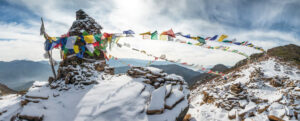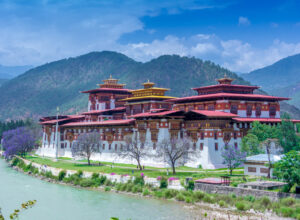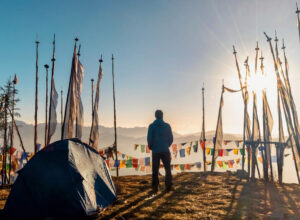
Planning a Trip to Bhutan 7 Important Tips to Keep in Mind:
Be Mindful of Peak and Off-Peak Seasons:
The prime tourist seasons in Bhutan coincide with Spring (March to May) and Fall (September to November), with March, April, October, and November experiencing particularly high levels of activity. If you’re contemplating a visit during these months, it’s advisable to secure your tour package and flight tickets at least three months in advance to ensure availability.
In 2010, Drukair tickets were completely sold out for three consecutive weeks, underscoring the importance of proactive planning to circumvent potential disappointments. These months are popular due to vibrant festivals and optimal trekking conditions.
For those seeking a less crowded experience, opting for travel during the non-peak period is recommended.
Price Disparities Between Peak and Off-Peak Seasons:
While Bhutan has done away with the minimum daily rate policy (MDRP) starting from September 2022, thanks to the introduction of the new Bhutan Tourism Act 2022, there remains a variation in accommodation costs between peak and non-peak periods. The difference in expenses during peak season can be as significant as 50% compared to non-peak seasons.
Additional Fee for Groups of 2 or Fewer Travelers:
Solo or duo travelers should be aware of the pricing distinction for individuals or couples, as the majority of Bhutan tours operate as private tours. Even if you are a solo traveler, you will still be allocated one licensed tour guide, a car, and a driver. This arrangement is commonly referred to as FIT (Free Independent Traveler) or a single surcharge in many countries.
First-Time Travelers’ Guide to Bhutan:

Bhutan experiences peak tourist seasons in Spring (March – May) and Fall (September – November), with March, April, October, and November being particularly bustling. If you are contemplating a visit during these months, it is advisable to secure your tour package and flight tickets at least three months in advance to ensure your reservation.
In 2010, Drukair tickets were completely sold out for three consecutive weeks, underscoring the importance of proactive planning to avoid disappointment. These months attract more tourists due to the favorable conditions for festivals and trekking, which are significant attractions.
For those seeking to escape the crowds of the peak tourist period, consider traveling during the non-peak period.
Understanding the Seasons in Bhutan:

The ideal time to visit Bhutan depends on your preferences and activities. For trekking enthusiasts, the best months are April, May, September, and October, offering optimal weather conditions with clear blue skies and minimal mud. It’s worth noting that the monsoon season occurs from mid-June to mid-September, bringing light morning rain (1-2 hours) during this period. While heavy downpours are rare, trekking is generally not recommended, except for short day hikes.
Winter provides an excellent opportunity to witness the endangered black-necked crane in their winter habitat, particularly in the Phobjika valley. Summer, on the other hand, is perfect for mushroom picking, featuring events like the Matsutake Mushroom Festival, and offers the chance to marvel at (sometimes double) rainbows over the valleys. If your visit is motivated by a desire for solace or spiritual reasons, any time of the year is suitable.
Align Your Arrival with a Bhutanese Festival:

Immerse Yourself in Bhutanese Festivities Throughout the Year
Bhutan hosts numerous festivals throughout the year, with popular events like the Paro and Thimphu Tshechu taking place during the high tourist season. These festivals are known for their vibrant dances featuring elaborate costumes, drawing large crowds of Bhutanese attendees dressed in their finest attire and attracting significant tourist interest.
Beyond religious festivals, Bhutan offers a diverse array of events catering to various interests, including the Punakha Festival, Black Necked Crane Festival, Royal Highlander Festival, Ura Matsusake Mushroom Festival, and Haa Summer Festival, among others. For a more intimate experience and enhanced photo opportunities, consider attending lesser-known festivals.
The Dochula Pass Festival is another notable event providing a wonderful chance to witness members of the royal family of Bhutan.

Explore the Charm of a Homestay Experience:
To be candid, the suggestion of a homestay often elicits varied responses. Considering the substantial investment in the trip, many travelers prefer the relaxation of a hotel room. On the flip side, some enthusiasts appreciate the authenticity of residing with a local family, gaining firsthand insight into Bhutanese daily life.
If you’re genuinely contemplating this option, here are a few considerations: While some families offer modern amenities, not all have electricity or hot showers, resorting to boiling water with firewood. Despite potential facility limitations, the warmth of their hospitality more than compensates for any lack of conveniences.
Conclude in Opulence:

Embark on a journey through the picturesque landscapes of Bhutan, traversing valleys and immersing yourself in local culture with the possibility of a homestay. Culminate your exploration with a lavish retreat at a 5-star sanctuary like Uma Paro, where the allure of the Paro valley unfolds during complimentary yoga sessions. Indulge in opulence at renowned establishments such as Taj Tashi, Terma Linca, Amankora, Le Meridien, and Six Senses, each offering a haven of luxury and a range of holistic wellness programs, from guided meditation to ayurvedic therapies and rejuvenating massages.
Additional Insights for Our Readers:
Practical Tips for Your Bhutan Adventure:
1. Connectivity: While most hotels offer WiFi, for enhanced connectivity, consider obtaining a local SIM card from Tashi Cell or B-Mobile before your departure.
2. Language: Dzongkha is the official language, but English is widely spoken, making communication hassle-free.
3. Currency: The Ngultrum is Bhutan’s local currency, pegged to the Indian Rupee. Note that 500 and 1000 Indian Rupee denominations are not accepted.
4. Expenses: As tour packages are prepaid, keep cash for personal expenses. We recommend having around US$200 for souvenirs, tips, and drinks.
5. ATMs and Cards: ATMs in Bhutan may not work with international cards. Bring cash for exchange at Paro Airport. Credit cards are accepted at international hotel chains.
6. Tobacco: Cigarette import is permitted since 2021, but smoking in public is discouraged. Be discreet and smoke only in designated areas.
7. Dry Day: Tuesdays are designated as a national ‘dry day,’ with alcohol sales prohibited.
8. Weather and Clothing: Pack warm clothes, especially from November to March. Bhutan’s varied elevations warrant preparedness for temperature changes.
9. Entertainment: Bring books, movies, and personal entertainment for the trip, as nightlife is limited.
10. Music: Tune in to FM stations like 92, 965, and 99.9 for Western songs or enjoy local music on other stations.
11. Haggling: Haggling is possible, but don’t expect more than a 10% discount. Prices between shops are generally consistent.
12. Tipping: Tipping is not customary in restaurants and hotels, as it is handled by your guide. However, remember to tip your guide.
13. Motion Sickness: Be prepared for winding roads; bring motion sickness medication if needed.
14. Electrical Plugs: Carry a multi-purpose plug and universal adapter, as hotel rooms may have limited electrical outlets.
15. Photography: Check with your guide before taking photos or filming in religious institutions, as some areas may have restrictions.

